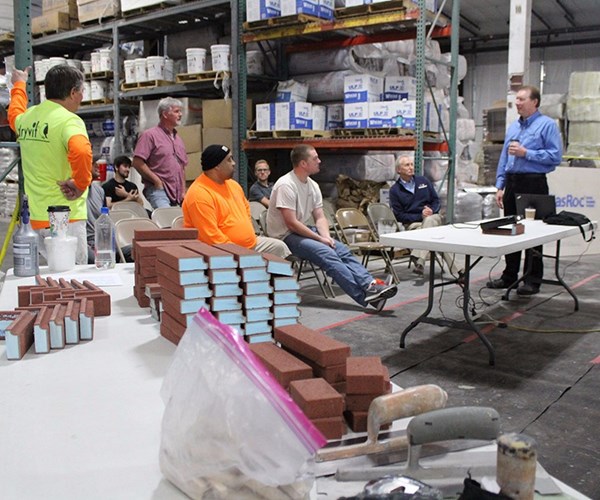New architectural composite hits the market
NewBrick by Dryvit (West Warwick, RI, US) is a new composite brick product, meant to substitute for venerable fired clay bricks and, the company says, revolutionize the installation of brick veneer façades and exteriors.

The brick facade shown here is a new composite product that replaces clay bricks, from NewBrick by Dryvit
NewBrick by Dryvit (West Warwick, RI, US) is a new composite brick product, meant to substitute for venerable fired clay bricks and, the company says, revolutionize the installation of brick veneer façades and exteriors. With the same general dimensions as a standard brick, NewBrick is a fraction of the weight, at 2.45 lbs/square ft compared to about 28 to 30 lbs/square ft, and has numerous reported benefits — more on that below.
NewBrick starts as slabs or boards of expanded polystyrene (XPS) foam, stacked on pallets. A hot wire cutting machine cuts the slabs lengthwise into “sticks,” which are then machined to form the patented lip along one edge, which allows speedy installation while providing a guide to stacking each brick course to leave the right gap for mortar application. Then, workers apply a mesh or scrim to each stick, which strengthens the foam and helps with puncture resistance. Next, a “base coating” is applied, the secret sauce that gives the product its color and texture, followed by a final finish coat, then cutting of the sticks into the individual bricks. NewBrick’s Christine Blonay, director of strategic marketing at DryVit, tells CW that the base coating is a cement-based matrix with proprietary polymer additives and chopped fiberglass, for strength and durability: “With normal maintenance, the product is designed to last for the design life of a building. The product is fully tested and meets all building code requirements, including structural, durability and fire, for use as a veneer for buildings of any height.”

Installers learn about NewBrick. Note the patented “lip” machined into the bricks to assist with installation.
NewBrick can replicate virtually any brick color and texture upon request, says the company, in addition to its standard offerings. The speed of installation is a key benefit, and the lighter weight means masons can easily carry 90-brick bundles up the scaffolding themselves. The lighter weight affords faster installation, with fewer people, saving money in the construction budget and project schedule. Scaffolding itself can be lighter, since it doesn’t have to support the 12-fold weight of real bricks, as can the building’s foundations, because they’re not bearing the weight of a clay brick façade. It can be directly adhered to nearly any substrate using adhesive, or applied with mortar. Dryvit claims that the product is much more energy efficient, with superior insulating benefits. And it meets all fire and building codes, according to Dryvit.
Visit http://www.newbrick.com/ to learn about NewBrick, including specifications, how to install, data on mortar and adhesives, cleaning, as well as more videos showing how it’s done.
Related Content
-
Combining multifunctional thermoplastic composites, additive manufacturing for next-gen airframe structures
The DOMMINIO project combines AFP with 3D printed gyroid cores, embedded SHM sensors and smart materials for induction-driven disassembly of parts at end of life.
-
Infinite Composites: Type V tanks for space, hydrogen, automotive and more
After a decade of proving its linerless, weight-saving composite tanks with NASA and more than 30 aerospace companies, this CryoSphere pioneer is scaling for growth in commercial space and sustainable transportation on Earth.
-
Recycling end-of-life composite parts: New methods, markets
From infrastructure solutions to consumer products, Polish recycler Anmet and Netherlands-based researchers are developing new methods for repurposing wind turbine blades and other composite parts.















